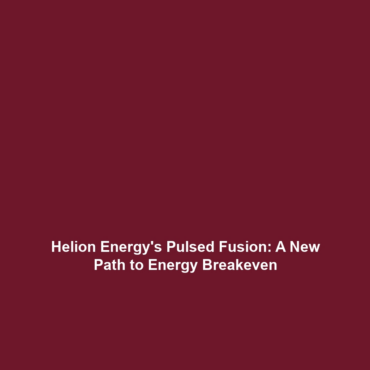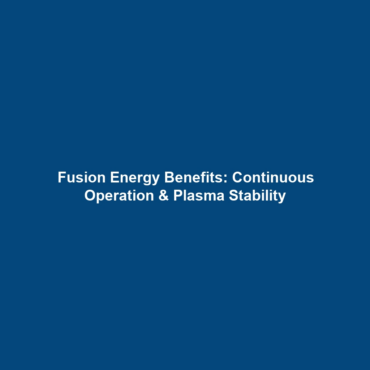Helion Energy: Developing a Novel Pulsed Fusion System for Energy Breakeven
Introduction: In the quest for sustainable and limitless energy, Helion Energy is at the forefront, developing a revolutionary pulsed fusion system that aims to achieve energy breakeven, a milestone that has baffled scientists for decades. This breakthrough could establish a new paradigm within the field of Fusion Energy, promising a cleaner, safer alternative to traditional energy sources. With potential applications ranging from electricity generation to propulsion systems, Helion Energy’s innovations could significantly shape the future of the energy landscape.
Key Concepts of Helion Energy’s Fusion Approach
Helion Energy’s approach to fusion centers around several critical concepts:
- Pulsed Fusion Technology: Unlike traditional continuous fusion reactors, Helion’s pulsed system focuses on short bursts of plasma confinement, which may lead to more manageable energy outputs and reduced operational costs.
- Magnetic Confinement: Utilizing advanced magnetic fields to contain and stabilize the fusion reactions, this method enhances the efficiency of energy capture while minimizing losses.
- Energy Breakeven: The ultimate goal of Helion’s innovations is to achieve a reactor design that produces as much energy as it consumes, thus ushering in a new era of viable fusion power.
Applications and Real-World Uses of Helion Energy’s Innovations
Helion Energy’s advancements in pulsed fusion technology hold promise in various fields:
- Clean Electricity Generation: By leveraging fusion energy, Helion aims to provide a renewable and almost inexhaustible source of electricity for homes and industries.
- Space Propulsion: The efficiency of Helion’s reactor design could enable the development of next-generation propulsion systems for space exploration, significantly reducing travel time to distant planets.
- Hydrogen Production: Fusion processes can potentially assist in producing hydrogen fuel, which is a critical component for a sustainable energy future.
Current Challenges in Fusion Energy Development
Despite its promise, Helion Energy faces several challenges that must be addressed for practical implementation:
- Technological Barriers: Creating a stable and efficient pulsed fusion reactor requires overcoming significant engineering and technological challenges.
- Funding and Investment: The high costs involved in research and development remain a hurdle, raising questions about financial sustainability.
- Regulatory and Safety Issues: As with any energy technology, navigating the regulatory landscape while ensuring safety is paramount.
Future Research and Innovations
Looking ahead, Helion Energy’s research is focused on several key areas:
- Material Science Improvements: Developing materials that can withstand the extreme conditions within a fusion reactor without degrading.
- Advanced Control Systems: Innovating control systems that can optimize the performance of pulsed fusion reactors in real-time.
- Collaboration Opportunities: Partnering with academic institutions and other organizations to accelerate research and share knowledge across the sector.
Conclusion
Helion Energy is redefining the boundaries of Fusion Energy with its innovative pulsed fusion system aimed at achieving energy breakeven. This undertaking not only holds the potential to transform energy production but also paves the way for future technological advancements across various applications. As we look toward a future powered by clean and sustainable energy sources, continued research and investment in this field are crucial. For more information on fusion energy advancements, explore our related articles on this topic.

